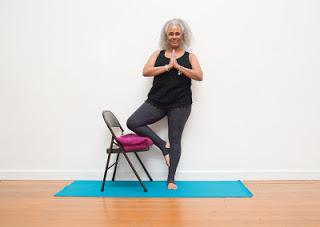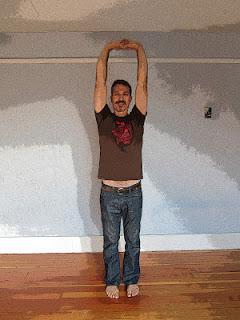
Photo by Melina Meza
Asana works to steady the mind through a focus on physical sensation, breath, or drishti (gaze). If we can bring that same focus into our Accessible Yoga practice, we quickly realize that the outward appearance of a pose is not a sign of whether or not someone is practicing yoga. What’s important is the mental focus and engagement. —Jivana HeymanI think this is a very good summation of what practicing yoga poses mindfully means. But I thought today I’d taking a closer look at what forms “mental focus and engagement” can take.
Much of the time in our everyday lives, our minds are preoccupied with our thoughts, including worries about the future, ruminations about the past, and judgments about the present. And that happens even when we’re in a yoga pose. A more lighthearted example of this is when I used to take a noon yoga class in my office building, I often found my mind was wandering to thoughts of what I was going to eat for lunch. To practice yoga poses mindfully means moving your mind away from your internal monolog and focusing on what you’re sensing in the yoga pose. The examples that Jivana uses are physical sensation, breath, and gaze.
But I think there is actually more to it than that, because you can use any of your seven senses (yes, I mean seven) in this way. And now I have to warn you that I’m going to use some fancy terms (which you may or may not have encountered in yoga classes before) to explain this. I hope this is not too annoying! I’m doing this because even if you don’t remember the terms after you read this post, I think you’ll have a better understanding of how to practice yoga poses mindfully.
Exteroception: This is a set of senses that provide our ability to interact with whatever environment we find ourselves in, whether indoors or outdoors, including all five of what we think of as our five senses: sight, hearing, taste, smell, and touch.
When Jivana talks about using physical sensation, that includes our sense of touch, such as the way we use our feet or other body parts to balance by sensing what type of surface we’re balancing on—even or uneven, soft or hard, etc.—and the feeling of our breath moving in and out of our nostrils. And when Jivana talks about using drishti (gaze), that would be using our sense of sight. But we can also use our hearing when we’re practicing poses or meditating, such as focusing on the sound of our breath. (We don’t typically use smell or taste in our asana practice—at least not intentionally.)
To work with exteroception, you could practice your standing poses by focusing on whether or not your feet are evenly pressing against the ground, and try to adjust them when you sense unevenness. Or, in your balance poses, you could focus your gaze on a focal point that is at the same height as your eyes to help steady yourself.

Focusing on your internal sensations is a very powerful practice. It helps keep you safe in a pose (as you can back away from pain in a joint or from overstretching) and for people with body image issues it helps you learn to fully inhabit or “reclaim” the body you have.
This can also provide a really good mental focus in a yoga pose. My long-time teacher Donald Moyer used to ask us to make an adjustment in a pose (haha, often by moving some obscure muscle or bone in some way no one had ever heard of before or thought about) and then observe how that subtle realignment caused a ripple of changes throughout the body that brought you either deeper into the pose or freed up some stuck area. Donald even said: Feeling an adjustment is concentration. Feeling the adjustment ripple through your body is meditation.”
To work with interoception, you can lie in Relaxation pose and guide yourself into complete physical relaxation by intentionally focusing different areas of your body, one by one, and relax and release each one are until your whole body melts into the ground.

Proprioception: This is an internal sense that allows you to feel where your body is in space. Proprioception is what allows you to walk in the dark (and what enables blind people to walk) and is an essential part of balancing. To observe this sense in action, try closing your eyes and bringing your finger to your nose.
"Proprioception" is actually a term that certain yoga teacher’s use when they talk about practicing mindfully. And you use your proprioception to move in and out of your yoga poses, such as when you position your back arm in Warrior 2 or step one foot back and turn the foot in Warrior 1, and to make minor adjustments while in the pose.
Although we use proprioception naturally in almost every pose we do, you can use it specifically as a way to engage your mind by doing poses with your eyes closed or by intentionally focusing on the parts of your body you can’t see even with your eyes open. Try moving into Triangle pose with your eyes closed. Or, as you bring your arms overhead and move into Upward Bound Hands pose, focus on sensing your arms move through space, your fingers entwining with each other, and your palms turning up toward the ceiling.

P.S. There actually may be more than seven senses, but right now I’m not aware of any other specific ones. Anyone know more about this?
Subscribe to Yoga for Healthy Aging by Email ° Follow Yoga for Healthy Aging on Facebook ° Join this site with Google Friend Connect

